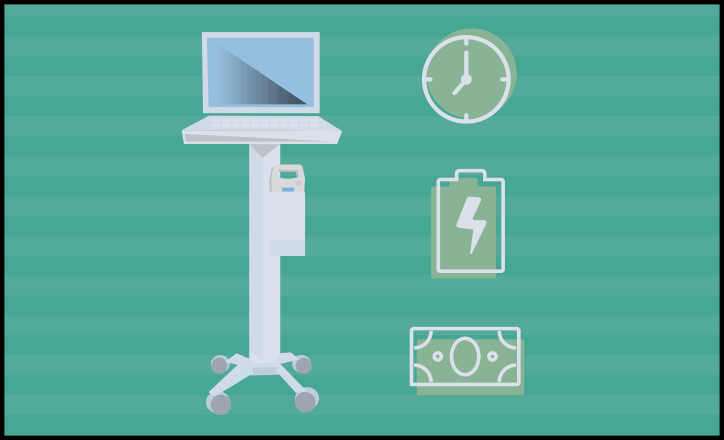
Corded vs Cordless Workstations (pt 3): Factors to Consider
Welcome back to our five-part blog series on the reasons why cordless EHR workstations are a better fit for nurses than those that have to be plugged in to charge. Read our overview of all factors to consider in part one and our discussion in part two about enhanced flexibility, efficiency, and convenience. Here in part three, we’ll delve into workstation availability, battery charge, and budget concerns.
Availability
Cordless EHR workstations using swappable battery technology, such as MobiusPower®, are always available for use in the busy 24/7 hospital cycle. They remain on the move around the clock because they don’t need to be plugged in—ever. They don’t require down time to charge. In a corded EHR workstation, however, the battery is internal; the only option to charge is to plug in. We can think of our laptops, tablets, and smartphones as examples. We’ve all had that moment of searching for an outlet in the airport, a coffee shop, or even in our homes, when one of our devices is running low. If we want to continue to use our device, we are then tethered to the wall, or we have to leave our phone next to the outlet to charge while we do something else.
With cordless workstations and external batteries, a nurse can swap out a depleted battery for a fully charged one in seconds. That ease of swapping allows the IT support team to quickly replace a weak battery that’s approaching end of life or one that has malfunctioned without doing any maintenance. A battery issue never renders a cordless workstation inoperable.
Battery charge
Workstations powered with MobiusPower swappable battery packs, however, take the anxiety surrounding battery life out of the nurse’s daily worries. MobiusPower displays the true time in hours and minutes. Plus, at 25 minutes remaining, the MobiusPower system gives an audible and visual reminder of the need to swap the battery. Even if a nurse is administering medication or starting an IV, he or she has plenty of time to finish with that patient. Then the nurse can roll down to the charging station to swap batteries in a matter of seconds before going on to the next patient.
Budget
A cordless system can be more expensive on a per-unit basis, but it allows a hospital to employ lean business practices. That hospital can run on fewer EHR workstations because there is no down time for recharging. With a cordless system, each workstation will have two external batteries, (rather than one internal). One swappable battery remains in the workstation’s holster, powering that workstation, while the other charges in the wall-mounted bay. A hospital can operate with a 10% to 20% smaller fleet this way—not only reducing the workstation count but also all the software licensing and IT equipment that must be maintained.
By increasing workstation availability, eliminating battery anxiety, and reducing overall spend, cordless EHR workstations deliver more value than corded solutions.
At Enovate Medical, we take time with our clients, working directly with nurses and IT professionals, to conduct a thorough clinical device assessment (CDA). In doing so, our clients have lowered their overall capital outlay and reduced their operational expenses. Most importantly, they’ve achieved enhanced nursing workflow and therefore an improved patient experience.
Call today for a comprehensive clinical device assessment.

